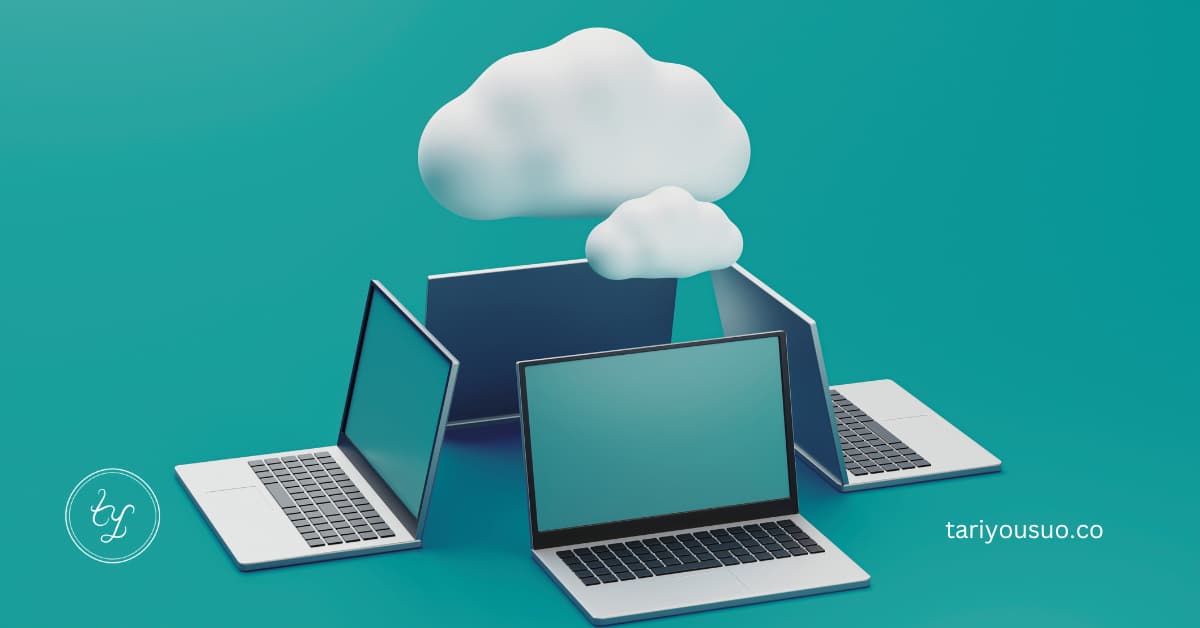by
What is Cloud Computing and Why is it Important

28/05/2025
A cloud computing expert once said that if you ask ten professionals what cloud computing means, you’ll get ten different answers.
That shows how people have made it seem complex, like an arcane art high up in the sky, beyond the reach of mere men like us. But in reality, that’s not the case, and I’m here to prove it to you.
In this article, I’ll break down cloud computing, show you the benefits, and give you a nudge off the cliff, so you can start using it to your advantage.
What Exactly Is Cloud Computing?
To easily understand cloud computing, you need to know what “computing” means.
Computing explained.
Originally, computing referred to the calculations done by computers as they try to follow instructions, process information, and execute commands.
But as computers advanced, computing expanded to mean all the things a computer can do. Things like browsing the internet, creating and editing documents, analyzing data, creating videos, playing games, storing data, etc.
Computing is the background process that enables you to do whatever you want with your computer.
Whenever you use your computer for any task, we can say it’s computing.
Cloud computing meaning.
Cloud computing is the use of computing resources over the internet, as opposed to having them in your physical location.
Stay with me, I’ll explain.
Normally, whenever you do anything with your computer (desktop, laptop, smartphone, etc), you use the hardware and software in it. The processors, memory, and other components, alongside the operating system and applications installed. They’re there with you, physically.
But with cloud computing, you use the hardware and software of another computer in a remote location.
That means, whatever you want to do, you do it via an internet connection to a network of computers in the cloud.
Cloud simply means the network of computers on the internet that carry out your desired task. They’re in a distant location beyond reach, just like the clouds in the sky.
Two examples of cloud computing.
– Data storage. Instead of storing data on your own device, you can upload it to another computer in the cloud. E.g. Google Drive, Dropbox, iCloud.
– Word processing. Instead of installing software on your computer, you can use a browser to access the cloud platform, create documents, and store them online.
Characteristics Of Cloud Computing.
The National Institute of Standards and Technology gives 5 characteristics of cloud computing.
1. On-demand self-service.
Consumers should be able to access the cloud platform and set up whatever computing resource they need automatically. For example, if you need 1 Terabyte of cloud storage space, you should be able to get it yourself.
2. Broad network access.
Users should be able to access the cloud platform from anywhere in the world, with any device (desktops, laptops, tablets, smartphones, etc.), provided there’s an internet connection.
3. Resource pooling.
This is best explained with an example.
Think of how a library maintains a huge collection of books. We can say the library has a pool of books. Users go there to read, or even borrow books, but they don’t own them. The books belong to the library.
Similarly, a cloud service provider has a pool of computing resources that provide storage, processing, memory, and networking services.
Consumers share the computing resources of the cloud service provider.
This is cost-effective, and beneficial to both the cloud service provider and the consumer. The cloud service provider won’t have wasted resources, while consumers don’t have to spend a large sum of money to buy needed hardware, or spend big on maintenance of equipment.
4. Rapid elasticity.
Consumers should be able to easily scale up or scale down in as little time as possible.
That means, if you suddenly need more storage space, you should be able to get it in no time. If you need less processing power, you should be able to scale down quickly.
5. Measured service..
There should be a way of measuring the usage of computing resources, to ensure consumers only pay for what they use.
Pros And Cons Of Cloud Computing.
There are many advantages of cloud computing over setting up your computers on premise. But as with everything in life, it also has its challenges.
Pros.
A few benefits of cloud computing.
1. Instant set-up.
With a few clicks you can set up systems to meet your computing needs.
2. Save time.
Unlike on premise computing where you have to source for hardware, install operating systems, and other needed software, cloud computing saves time because the infrastructure is already provided by the cloud company.
3. Cost-effectiveness.
This is beneficial to both you (the consumer), and the cloud service provider.
You don’t have to make the initial investment needed to buy expensive hardware, install required software, or run your own data center. You also don’t need to worry about operation costs and regular maintenance.
You only pay for what you use.
As for the cloud service provider, there is more effective use of resources, since the same operation and maintenance cost covers a large number of users.
4. Scalability.
This is one strong benefit of cloud computing. It is easy to scale up or scale down, according to business needs.
If you were to set up your own computing infrastructure, your ability to scale quickly will be limited.
For example, let’s say you have a sudden increase in the number of people accessing your server. It can cause overload and downtime. You’d spend days, at best, to buy the required hardware, set it up, and get it running. On the other hand, let’s say demand has reduced, scaling down won’t be easy without cloud computing. You’d have excess resources wasting away.
But with cloud computing, you only pay for what you use, and can easily acquire and deploy more resources, or cut down as needed.
5. Accessibility.
Being able to use your business applications, access stored data, and serve your customers from anywhere in the world is a powerful advantage.
Thanks to cloud computing, remote work is possible.
You don’t have to be in the office, or a specific location to attend to your customers.
Also, you can run an international team, across different time zones.
6. Data recovery.
Because your data is stored in the cloud, you worry less about data loss.
In the unfortunate event that your system or storage device crashes, you can easily retrieve your data from backups in the cloud.
7. Automatic updates and upgrades.
It is the duty of the service provider to keep up with the latest technology for faster, more powerful, and more efficient computing.
Users can also set up automatic software updates.
Cons.
Some challenges that come with cloud computing.
1. Security.
Although on premise data centers also face security challenges, cloud computing brings more complexity, and a breach can be more devastating.
Measures have to be put in place, and you have to move cautiously to ensure the security of your customers and your data.
2. Lack of expertise.
Although, with a little effort, simple tasks can be set up, and computing resources deployed, advanced business solutions need people with experience in the cloud computing space. Especially in areas of cloud security and development.
Sourcing for talent, and also paying them their worth might be daunting.
3. Dependence on service providers.
Although we have good faith in the largest cloud service providers, the dependence on them can be limiting.
They might not offer the kind of service you need, so you have to make do with their listing.
Also, if anything goes south in their service delivery, there’s barely anything you can do.
The 4 Types Of Cloud Computing.
These are called cloud deployment models.
1. Private cloud.
With private cloud, an enterprise sets up their own cloud platform.
Although this comes with upfront spending and regular maintenance costs, it has the benefit of being in control of your cloud platform and developing it to meet your specific needs.
This is for large businesses who want to take advantage of the benefits of cloud computing, without relying heavily on third party service providers.
2. Public cloud.
This is the most common.
It is provided by major players like Amazon, Microsoft, and Google.
Here, service providers set up the cloud infrastructure, and are responsible for maintenance costs. Consumers use the cloud on a pay-as-you-go basis.
3. Hybrid cloud.
Hybrid cloud is simply a combination of private and public cloud.
Enterprises can choose to use both public cloud and private cloud to meet the computing needs of their business.
They can use the private cloud for core business needs, while running other functions in the public cloud.
4. Community cloud.
This is similar to the public cloud. The difference is that while the public cloud can be used for any type of business or computing need, community cloud is dedicated to a particular vertical.
For example, a cloud platform for developers, a cloud platform for sales and customer relationship management, a cloud platform for AI and Machine Learning.
3 Examples Of Cloud Computing Services.
1. Infrastructure as a Service (IaaS)
The cloud company provides the foundational computing infrastructure, such as processing power, memory, storage, and networking.
Consumers can run servers, build software, and deploy applications using the infrastructure provided in the cloud.
2. Platform as a Service (PaaS).
This is especially useful for developers, software engineers, data scientists, or other technical experts.
Asides the infrastructure, the cloud service provider also sets up development environments, software packages, and containers for the user.
That means the user can jump right into their technical work like software development, data analysis/machine learning, etc., without worrying about setting up the required environment.
3. Software as a Service.
This is targeted at end users. Fully functional applications are developed, and ready for use. All that is required is an internet connection, and account registration to use the apps right away.
A few examples include Gmail, Google Suite (Drive, Slides, Sheets, etc.), Netflix, and online games.
An easy way to look at cloud deployment models.
Infrastructure as a Service is like buying a computer, without installing any operating system or software. You decide how you want to use the computer and what type of operating system to install.
Platform as a Service is like installing the operating system of your choice. That is, the cloud service provider provides the infrastructure, and the foundational software packages needed to build or run end user applications.
Software as a Service is like installing your favorite applications or games. So a cloud service provider runs the infrastructure and the operating systems, builds end applications, and deploys them for use over the internet.
All you do is connect and use the apps on the go.
Why Cloud Computing Is Important.
One importance of cloud computing is the leverage it gives. Users can access the latest and most powerful computers from anywhere in the world, without having to break the bank.
Also;
– Businesses can scale up or down as required, ensuring management of resources. The worry of maintenance costs is handled by the cloud service provider.
– Developers and Engineers can focus on the most important tasks, development, without worrying about setting up and maintaining the infrastructure needed.
– Teams can collaborate easily, from different parts of the world. Updates are seen in real-time. Instant feedback can be gotten from customers.
Conclusion – Launch Into The Cloud.
Whether you’re a developer, data scientist, or business owner, you should consider the advantages the cloud has to offer.
Cloud service providers like Amazon Web Services, Microsoft Azure, and Google Cloud Platform offer free trials, even up to 30 days, to test their offerings.
If you need access to a larger storage, more compute power for complex processes, or servers to host your website, try them out to see how they can make your work faster, efficient, and productive.
